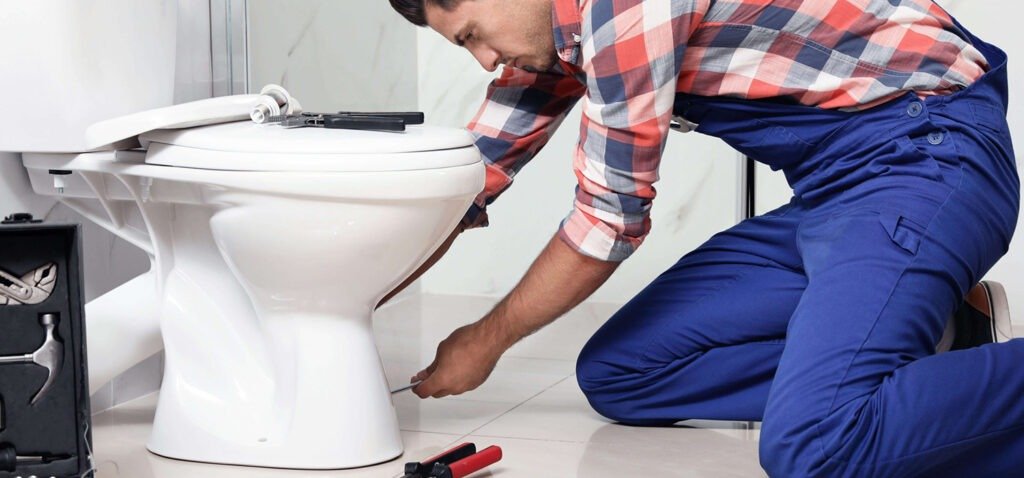A properly functioning toilet is essential for everyday comfort and hygiene. When problems arise, timely Toilet Repair service can prevent further damage and costly repairs. Common issues like running toilets, leaks, and clogs often result from wear and tear, improper use, or plumbing faults that need expert attention to restore full functionality.
Knowing common toilet problems helps Westwood MA homeowners spot issues early and fix them easily. For expert Toilet Repair service, contact T.E. Foley Home Services to keep your bathroom running smoothly.
Running Toilet
One of the most common toilet problems is a running toilet. This happens when water continuously flows from the tank into the bowl, causing water waste and higher utility bills. The primary causes include a faulty flapper, misaligned float, or worn-out fill valve.
Fix:
- Check and replace the flapper if it’s damaged or not sealing properly.
- Adjust the float to stop water at the correct level.
- Replace the fill valve if it’s old or malfunctioning.
Clogged Toilet
A clogged toilet is a frustrating but typical problem caused by flushing too much toilet paper, non-flushable items, or buildup in the drain line. Clogs can cause slow drainage or overflow, creating an unsanitary mess.
Fix:
- Use a plunger to clear minor clogs.
- For stubborn blockages, a toilet auger or drain snake can be effective.
- Avoid flushing items like wipes, sanitary products, or excess paper.
Weak Flush
A toilet with a weak flush fails to clear waste effectively, often requiring multiple flushes. This problem is usually caused by clogged rim holes, low water levels in the tank, or partial clogs in the trap or drain.
Fix:
- Clean the rim holes under the toilet bowl’s edge with a wire or brush to remove mineral deposits.
- Ensure the tank water level is set correctly (usually about an inch below the overflow tube).
- Check for partial clogs and clear them if necessary.
Toilet Leaks
Leaks around the base of the toilet or from the tank can cause water damage and increase water bills. Leaks may be due to a faulty wax ring seal, cracked toilet bowl, or loose bolts.
Fix:
- Tighten the bolts connecting the toilet to the floor.
- Replace the wax ring seal if water is leaking at the base.
- Inspect the toilet for cracks and replace if needed.
Phantom Flushes
Phantom flushing happens when the toilet tank refills randomly without flushing. This issue is caused by a slow leak from the tank to the bowl, usually due to a worn flapper or valve seal.
Fix:
- Replace the flapper or valve seal to stop water from leaking into the bowl.
- Check for any debris preventing the flapper from sealing properly.
Slow Tank Fill
If your toilet tank fills slowly after flushing, it could be due to a clogged fill valve or low water pressure. This delay can make the toilet inconvenient to use.
Fix:
- Clean or replace the fill valve if mineral buildup is causing blockages.
- Consult a plumber if low water pressure is suspected.
Toilet Handle Problems
A loose or stuck toilet handle can prevent proper flushing. This issue may arise from a broken or disconnected lift chain inside the tank or a faulty handle mechanism.
Fix:
- Adjust or replace the lift chain so it moves freely without being too tight or loose.
- Replace the handle mechanism if it is broken or corroded.
Noisy Toilet
Noises such as hissing, banging, or gurgling often indicate issues within the toilet’s fill valve, water supply line, or vent pipes. These sounds can be disruptive and point to underlying plumbing problems.
Fix:
- Replace or repair the fill valve to stop hissing sounds.
- Inspect water supply lines for loose fittings.
- If gurgling continues, it may indicate vent pipe blockage requiring professional attention.
Tips to Prevent Common Toilet Problems
- Avoid flushing anything other than waste and toilet paper.
- Regularly inspect and clean your toilet tank and bowl.
- Schedule routine plumbing inspections to catch problems early.
- Use water-efficient toilets to reduce strain on your plumbing system.
Conclusion
In summary, being aware of the most common toilet problems and their solutions can help you maintain a functional and efficient bathroom. Regular maintenance, timely repairs, and understanding when to seek professional help are key to preventing costly damage and inconveniences. By addressing issues like running toilets, clogs, leaks, and weak flushes promptly, you can ensure your plumbing system operates smoothly and your home stays comfortable and hygienic.
FAQs
- How often should I check my toilet for leaks?
It’s good practice to check for leaks at least once every six months to prevent water damage and wasted water. - Can I use chemical drain cleaners to fix toilet clogs?
It’s generally better to avoid harsh chemical cleaners as they can damage pipes and the toilet’s components. Mechanical methods like plungers or augers are safer. - What causes a toilet to keep running after flushing?
Most often, a faulty flapper or a misadjusted float causes continuous running water. - How do I know if my wax ring seal needs replacing?
Signs include water leaking at the base of the toilet or a foul sewer odor in your bathroom. - When should I call a plumber for toilet problems?
If simple fixes don’t resolve issues like leaks, persistent clogs, or noisy plumbing, it’s best to contact a professional plumber.










































